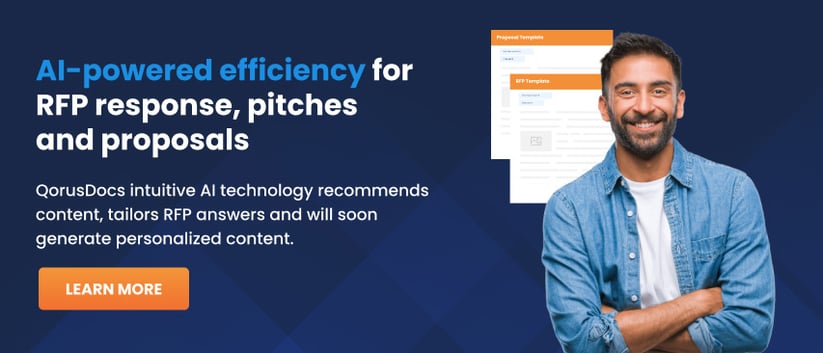How Insight Scaled Proposal Workflows with QorusDocs
Part 1: What is ChatGPT?
Generative AI is the talk of the town these days, with AI-powered tools and technologies cropping up in multiple industries and professional disciplines, impacting consumers and businesses alike. In this blog series, we’ll take a look at ChatGPT technology and its impact on the category of Proposal Management. We’ll examine how proposal teams can leverage generative AI tools to help them create and manage content more efficiently and effectively and we’ll discuss the risks, challenges, and opportunities of leveraging AI-powered technologies to drive the proposal and RFP response process.
Plus, this series will explore how professional services firms, in particular, can accelerate and streamline their pursuit process with generative AI tools. We’ll dig into how—with ChatGPT in their response management toolbox—firms can increase the number of optimized, accurate, and on-brand proposals, pitches, and RFP responses they send out to help secure a steady flow of new client business.
Let’s get started with the basics.
Understanding ChatGPT
ChatGPT is making headlines around the globe, both in the consumer sphere and in B2B environments. Your nephew is using ChatGPT to write his term paper; your colleague is using the tool to lighten the load of compiling her end-of-quarter reports. You’ve heard friends, family, and industry experts extol the virtues of generative AI and ChatGPT for boosting efficiency and productivity across many processes, from healthcare and manufacturing to professional services and academia. But what exactly is ChatGPT?
Chat Generative Pre-trained Transformer, known familiarly as ChatGPT, makes use of natural language processing (NLP) to interact in a conversational way, engaging with and responding to natural human language. The pre-trained generative chatbot can generate coherent and logical sentences in response to text-based user prompts in a conversational dialogue.
The bottom line is that ChatGPT enables you to have human-like conversations, answering questions and assisting you with tasks such as composing emails, drafting reports, or reformatting text. In the words of OpenAI, the creators of ChatGPT, the dialogue format “makes it possible for ChatGPT to answer follow-up questions, admit its mistakes, challenge incorrect premises, and reject inappropriate requests.”
The power of large language models
Generative AI applications, like ChatGPT, are part of the broad category of machine learning (ML) that have been trained on large language models (LLMs). What is an LLM? Simply put, an LLM is a trained deep-learning model that understands and generates text in a human-like fashion; it can perform a range of NLP tasks (e.g., generating and classifying text, translating text into different languages).
The “large” label refers to the number of values, aka parameters, the LLM can change autonomously as it learns—sometimes as many as hundreds of billions of parameters. Indeed, LLMs are trained with vast amounts of data, employing deep learning algorithms to generate very well-structured, sensible, and human-like responses.
Researching, writing, analyzing
With a generative AI tool like ChatGPT, you can research content, write content, and then analyze that content. Instead of having someone on your team focused on providing answers from a static set of pre-defined answers, ChatGPT can act like the assistant you’ve always wished you had, analyzing content to derive the best answers and formulating new text based on analysis to optimize the response process.
To generate the highest-performing content for your proposal, for example, ChatGPT will read through predefined answers, past answers from previous RFP responses, past proposals, marketing collateral—whatever content you designate; content can come from a range of sources, such as a private dataset of closed content within your organization or content from the public domain. (Pro tip: Be cautious releasing private data to the public ChatGPT because you risk exposing internal confidential information to the public.
Next, the generative AI tool will analyze this information to find the right data points and create new text based on the analysis and the research. This entire process transpires in an instant, generating valuable, real-time content to use in your proposals and pitches and minimizing the time spent responding to long lists of RFP questions.
Enhancing the client experience
In addition to accelerating content creation and streamlining the response management process, generative AI technology like ChatGPT can help automate customer interactions. At most organizations, the customer service team ends up answering the same questions from clients over and over.
If the answers to frequently asked questions are in a database (structured or unstructured), generative AI can instantly research, analyze the response data, and generate answers in a way that's very easy for clients to understand. By eliminating the repetitive queries client reps typically handle on a daily basis, ChatGPT helps free up time to focus on more value-add customer-facing tasks to improve the client experience.
To dig deeper into the world of generative AI, watch our “AI for Response Management” video series, featuring CEO and QorusDocs co-founder, Ray Meiring, sharing his thoughts on generative AI and its impact on how organizations secure new client business. In the first video of the series, Ray explains in plain language how ChatGPT works and how it can help your team.

October 3, 2023




